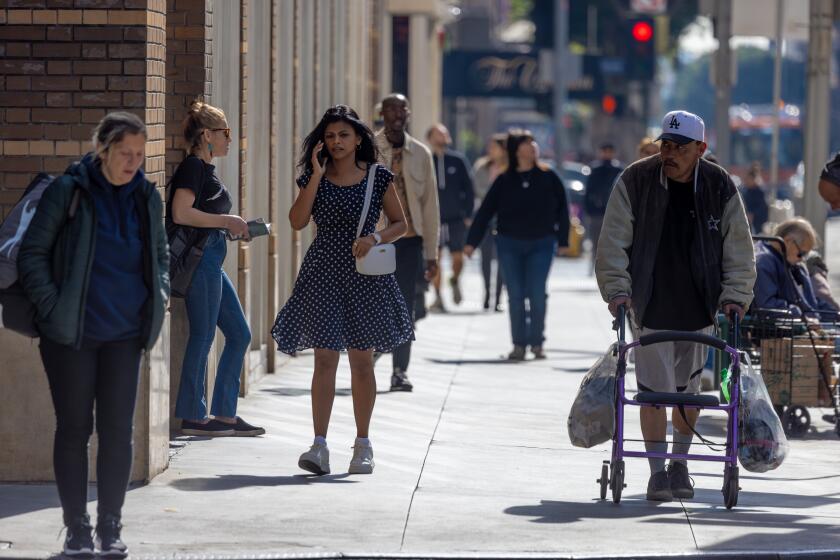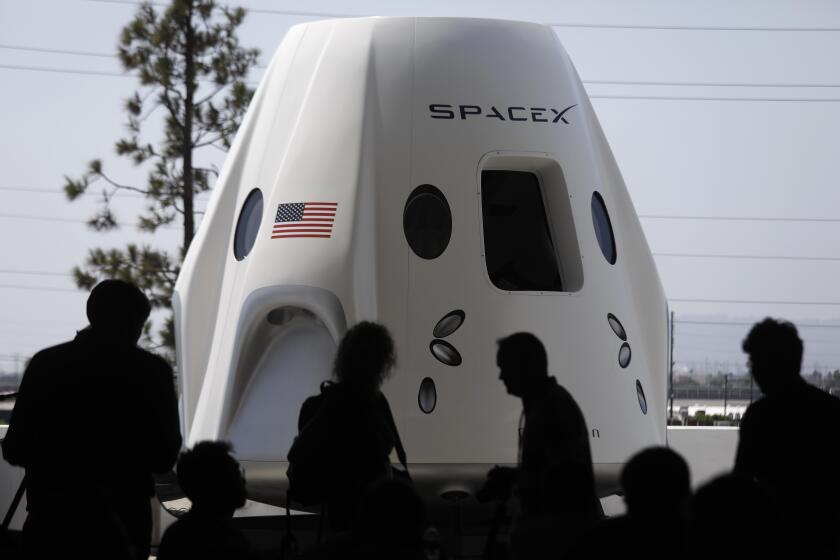Opinion: California ruled with great jobs and boom times. What happened?

- Share via
Gov. Gavin Newsom’s constant reminders that California’s economy ”leads the nation” as well as being a model for social justice are delusional. To be sure, California has a huge GDP, paced largely by high real estate prices and the stock value of a handful of tech companies, but it is not widely seen as a place for class mobility, and it is slowly ceding its dominance, even in tech-related industries.
In contemporary California, home to four of the world’s seven most valued tech firms, tech bros and real estate speculators occupy what Lenin called “the commanding heights,” while the reality on the ground is far less ethereal. The view from where most Californians reside is revealed in a new study sponsored by Chapman University: “Is California Losing Its Mojo?,” by business professors Marshall Toplansky (Chapman) and Kenneth Murphy (UC Irvine).
President-elect Trump has vowed that his return to the White House will bring about a resurgence of blue-collar work across the country.
Historically, the report notes, California has outpaced the rest of the country in terms of the growth of its goods and services. However, that pace of GDP growth in the state has dropped significantly since 2022, with the measure now lagging when compared with other states. The distribution of jobs and wealth is even more worrisome.
California has been a particularly poor bet for blue-collar professions, such as manufacturing, the traditional path to upward mobility for minorities and non-college educated people. Bureau of Labor Statistics data, analyzed by Lightcast, shows California has lagged far behind places like Utah, Nevada, Texas and Arizona over a decade.
A Hoover Institution analysis claiming that 96% of California job growth is in government jobs is dead wrong, but it got taken up by right-wing California bashers anyway.
The Chapman paper acknowledges that the state has experienced enough job growth to keep unemployment levels low, but as the report details, most new jobs in California aren’t concentrated in high-wage sectors. Over the last 10 years, 62% of jobs added in California were in lower-than-average paying industries, versus 51.6% for the nation as a whole. In the last three years, the situation worsened, with 78.1% of all jobs added in California coming from lower-than-average paying industries, versus 61% for the nation as a whole.
In a state with high living costs, a dearth of well-paying jobs seems likely to bear responsibility for the state’s out-migration rate and its poverty rate, which the Census Bureau calculates, in its most comprehensive estimate, as 15.4%, one of the highest in the nation. California may be home to a lot of billionaires, but it also is home to nearly 30% of the country’s homeless.
Of course, not everyone has suffered. Besides tech billionaires, who is doing well in California? Older homeowners, for one, whose bottom line has risen as home values increased dramatically. Government workers have also thrived.
More than half of California’s counties have populations lower than they were in 2019, according to data from the state Department of Finance. The state has yet to recover from the exodus.
Census Bureau data highlighted in the Chapman report show that California public sector job growth over the last decade has been growing at about the same pace as jobs overall in California, but the average annual pay for those government jobs was almost double that of private sector jobs. In other words, the road to the middle class comes not from private employment but from jobs that are funded by taxpayers.
In the past, California cities including San Francisco, San Jose and San Diego all ranked in the top 10 among hubs for “advanced industry” employment — where there’s high investment in R&D and a high percentage of STEM roles. But since 2020, only San Jose remains in the top 25 metro areas for growth in such employment. Today the emerging hot spots are often east of the Sierra: Austin, Texas; Nashville; Indianapolis; Salt Lake City; and Phoenix.
Can California get its mojo back? After all, many of the state’s assets — research universities, leading tech firms and the lifestyle appeal — have not disappeared.
SpaceX’s plans to launch more rockets from California’s coast were rejected by a state commission this week, with some officials citing Elon Musk’s political posts on X.
First, Newsom and other state cheerleaders have to stop using the size of the economy as a cover for real problems. Whatever the state’s strengths, as the Chapman report puts it, low-wage jobs overtaking advanced industry work is not sustainable.
The Biden administration emphasized bringing manufacturing back to the U.S., and President-elect Donald Trump promises to do the same, but California misses out on opportunities due to the costs associated with its regulatory regimes.
Consider technologies largely developed and embraced by California, such as EVs and the batteries that run them. Jobs in those manufacturing industries overwhelmingly fall to red states, largely a reflection of such things as easier permitting rules, lower energy costs and less intrusive labor regulations.
Citing street crime and new transgender school law he calls the last straw, Elon Musk says he is moving the headquarters of SpaceX and X from California to Texas.
Remarkably, Newsom, who feuds with Elon Musk and has taken on the role of the national anti-Trump, has promised that if the next administration in Washington eliminates the federal $7,500 buyer EV tax credits, California will step in with state rebates for the vehicles — with reportedly one exception, Teslas, which happen to be the dominant American brand and the only EVs made in California. The plant in Fremont employs thousands in good manufacturing jobs.
And that’s hardly the end of the self-destructive politicking.
One “advanced industry” where California, and in particular Southern California, still has a leg up is aerospace, and its corollary, defense. The state remains well in the lead in terms of aerospace-related employment, and innovative new firms, such as Anduril in Orange County, seem primed to take advantage of Trump’s emphasis on military spending. In his first term, he increased the defense budget to historic highs.
Gov. Gavin Newsom says, ‘I’m with Elon,’ in dispute between the billionaire and the California Coastal Commission over how many rockets Musk’s SpaceX can launch.
But is California’s Democratic leadership on board?
Once again, the state’s relations with Musk, Trump “first buddy” and the world’s preeminent space pioneer, would indicate just the opposite. Musk, upset at a California law that allows schools to keep parents in the dark when their children identify as LGBTQ+, decided to move SpaceX’s headquarters from Hawthorne to Texas this year. And just weeks ago, the California Coastal Commission denied SpaceX’s request to increase its rocket launches from Vandenberg Air Force Base; reportedly after commissioners discussed his political views before they voted on the issue. Even Newsom objected.
This is not the way to build a truly inclusive and healthy economy. Gavin Newsom can talk all he wants about California’s bounty, but the road the state’s Democrats have set for us has been profoundly regressive.
Joel Kotkin is a contributing writer to Opinion, the presidential fellow for urban futures at Chapman University and senior research fellow at the Civitas Institute at the University of Texas, Austin.
More to Read
A cure for the common opinion
Get thought-provoking perspectives with our weekly newsletter.
You may occasionally receive promotional content from the Los Angeles Times.















